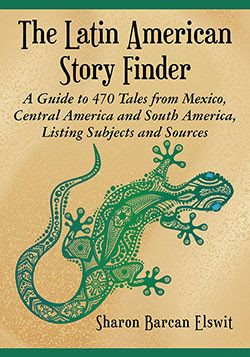Named a Best Reference Book from Library Journal …“a pleasure for instructional purposes.”
It gives me great pleasure to be able to share the path to 470 stories from a part of the world often neglected in folklore collections.
Look here to find your way to satisfying stories of social justice and warnings by creatures – Chullachaki, Curupria, Sachamama, Mapinguari, Epereji, dolphin policemen – who fiercely protect the Amazon.
Here you will discover secrets: why the gods do not let humans know everything, how Aunt Misery can trap Death in a pear tree, how the irresistible Iara with beautiful long hair and song lures men to her watery realm , and how the Virgin of Guadalupe gives the peasant Juan Diego confidence to face a Spanish bishop in Mexico’s capital city.
There’s wonder and humor and, oh so much humanity. From the story of the Yaghan People of Chile, a brave young man whose community is being destroyed by wild hairy monsters travels along the bottom of the ocean to a wise woman who gives him a magic shell, which will bring an icy death to himself, too, but save his people. In a story from the Warao People of Venezuela, people in canoes crowd the Orinoco River to be near the enchanting box the chief’s younger daughter has brought back from the keeper to light their world. Over and over, Pedro de Urdemalas outwits rich owners, and Rabbit tricks the bullies.
The more I traveled into the stories from the people of Mexico, Central America, and South America, the more excited I became. What a melding of cultures!
They come:
- from 21 countries and 75 indigenous tribes
- blending the culture of Spanish and Portuguese colonials who arrived in the 16th century with
- tales collected and told by Catholic missionaries and Sephardic Jews fleeing the Inquisition in Europe
- tales changed and changed by native Quechua, Maya, Inca, and Amazonian cultures
- plus tales told by indentured servants from India, and the Anansi stories which came over with African slaves.
And the stories are not just of interest for children.
As the Preface says:
Everything is possible when you step into the magically real world of Latin American folklore – a buzzard can change places with a wife’s lazy husband; a hunter may hurl thunder and lightning bolts down on the tribesmen who cheated him of his share of the meat; a shapeshifting pink dolphin from the Amazon may seduce a young woman to his underwater city; and the lizard a padre scoops off a dusty road may become the emerald he hands it to a poor peasant who needs to buy medicine for his wife. Here, a lone man after a cataclysmic flood sees his black dog slip out of its skin and become a young woman who cooks tortillas and will become his companion in the new world. The folktales deal with timeless key human questions, and there are human truths in the magic they contain.
Click here for the full Table of Contents.
Entries in this Finder list variants sources for the stories and provide sources. I found some stories, like The Land of Icy Death, in only one place, but others have been told in several cultures and in different ways within the same country. Here’s a sample of what you’ll find inside the Finder:
- The Little Tenca and the Snowflake Brenda Hughes, Folk-tales from Chile
A little tenca bird scolds the biting winter snow when a snowflake burns her foot, while she is out trying to find food. The snowflake says it is the fault of the sun, which was causing it to melt. The sun tells her the cloud is at fault for covering it. The cloud blames the wind; the wind blames the wall; the wall blames the mouse who blames the cat who blames the dog who blames the stick who blames the fire who blames the water who blames the knife who blames the man responsible for making it. The man tells the little tenca to ask God who made him. Very tired now, the little tenca flies up to God and wants to know why God created man. Sympathetic to her grief, God tells the little tenca to fly back and take care of her hungry babies. She does and finds her foot healed.
CONNECTIONS: Accusations Ants Birds Cause and effect God Gods and animals Humans Insects Journeys to other realms Justice Knives Miracles Murder Responsibility Snow
HOW ELSE THIS STORY IS TOLD: Chilean variation: The Thrush – Yolando Pino-Saavedra, Folktales of Chile A little thrush breaks her claw trying to look for food in the frost and demands justice from the sun, clouds, winds, wall, rat, cat, dog, stick, fire, water, ox, and knife, who each blame the next one, until the blacksmith finds the thrush annoying and kills her.
Jakaltek Maya variation from Guatemala: Author’s Preface – Victor Montejo, The Bird Who Cleans the World and Other Mayan Fables A wild dove pleads for cotton cloth because her leg is broken and to protect her from the cold, that has been caused by a string of characters.
Mexican variation: The Little Ant – Américo Paredes, Folktales of Mexico
***And here’s where you can find The Latin American Story Finder ***

